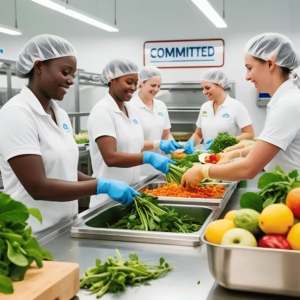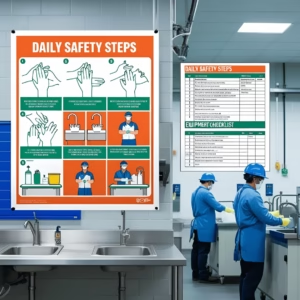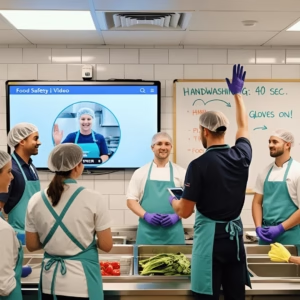Author: VAIBHAV — Food Safety Expert | Quality Executive | HACCP & FSSAI Certified
Introduction

Picture this: a customer opens your product—a jar of homemade jam, a pack of frozen samosas, or a bottle of fresh juice—and takes a bite, trusting it’s safe and delicious.
Now imagine the opposite: a contamination scare, a recall, or worse, someone getting sick. In the food industry, safety isn’t just a nice-to-have—it’s the heart of everything you do.
Whether you’re a small-scale entrepreneur or a big-name manufacturer, the stakes are high, and the responsibility is yours.
That’s where Good Manufacturing Practices (GMP) and Good Hygiene Practices (GHP) step in.
These aren’t just fancy terms to impress regulators; they’re practical, proven systems that protect your customers, keep you compliant with laws like FSSAI or FDA standards, and build a brand people rave about. I’ve spent years helping businesses master these frameworks, and in this guide,
I’m sharing everything you need to implement them—step by step, with real examples and no fluff. Ready to make food safety your superpower? Let’s get started!
What Are GMP and GHP? A Deep Dive

✅ Good Manufacturing Practices (GMP)
GMP is like the conductor of an orchestra—it ensures every part of your production process plays in harmony.
It’s a set of guidelines that govern how food is made, from the moment raw materials arrive to when the final product hits the shelf.
Think of it as a safety net for quality and consistency. Here’s what it covers:
- Raw Material Handling: Checking that your flour isn’t buggy or your spices aren’t stale.
Equipment Maintenance: Keeping machines clean and calibrated—like oiling a mixer so it doesn’t grind metal into dough. - Process Control: Following exact recipes and cooking times (e.g., pasteurizing milk at 161°F for 15 seconds).
- Packaging: Using tamper-proof seals to keep products safe during transport.
For example, a biscuit factory following GMP would test incoming wheat for mold, sanitize ovens daily, and ensure wrappers are free of punctures. It’s about controlling every detail so nothing slips through the cracks.
✅ Good Hygiene Practices (GHP)
If GMP is the big-picture strategy, GHP is the boots-on-the-ground execution.
It’s all about cleanliness—keeping germs, dirt, and pests out of your food. GHP focuses on the human and environmental side of safety:
- Personal Hygiene: Staff washing hands for 40 seconds with soap, wearing gloves, and tying back hair.
- Facility Cleanliness: Mopping floors with food-grade disinfectants and wiping counters after every shift.
- Pest Control: Sealing cracks and setting traps to keep rodents or flies at bay.
- Waste Management: Emptying bins daily so rotting scraps don’t attract trouble.
Picture a bustling kitchen making ready-to-eat salads: GHP means the chef’s apron is spotless, the cutting board is sanitized between uses, and no sneaky cockroach is darting across the counter.
When GMP and GHP work together, they create a fortress of safety around your food—leaving no room for error.
Why GMP & GHP Are Your Business’s Best Friends

✅ Prevent Foodborne Nightmares
Every year, millions fall ill from contaminated food—think Listeria in cheese or E. coli in spinach. GMP and GHP are your first line of defense. GMP ensures raw chicken is stored at 40°F or below to stop bacterial growth, while GHP keeps workers from spreading germs by enforcing glove use. A real case: in 2015, a U.S. peanut butter outbreak sickened dozens because of poor sanitation. With GMP and GHP, that could’ve been avoided
✅Build Trust That Lasts
Your customers aren’t just buying food—they’re buying peace of mind. A brand known for safety wins loyalty.
Take Amul, India’s dairy giant: their strict adherence to manufacturing and hygiene standards has made them a household name for decades.
GMP and GHP don’t just protect; they polish your reputation to a shine.
✅ Stay Compliant, Stress-Free
Regulations aren’t optional—FSSAI in India, FDA in the U.S., and Codex Alimentarius globally set the bar, and failing them means fines, closures, or bans.
GMP aligns your processes with legal standards (like proper labeling), while GHP ensures your facility passes surprise inspections.
Fun fact: compliance can also unlock export opportunities—imagine your spices on shelves in Europe!
Helpful Links: FSSAI Guidelines | Codex Alimentarius Standards
✅ Set the Stage for HACCP
If you’re eyeing a Hazard Analysis Critical Control Point (HACCP) system, GMP and GHP are your stepping stones.
HACCP pinpoints specific risks—like ensuring fish is cooked to kill parasites—but it relies on GMP’s process controls and GHP’s hygiene habits to work.
Without them, HACCP is like building a house without a foundation.
✅ Save Money, Time, and Headaches
Structured practices mean fewer mishaps.
A GMP-compliant juice plant checks pH levels to avoid spoilage, saving barrels of wasted product. GHP’s pest control stops infestations that could shut you down for weeks.
In 2020, a major recall cost a U.S. company millions—proper GMP could’ve caught the issue early. Efficiency isn’t just smart; it’s profitable.
Step-by-Step Guide: Implementing GMP & GHP Like a Pro
Step 1: Kick Off with a Thorough Food Safety Assessment

You can’t fix what you don’t see. Start by auditing your operation top to bottom—think of it as a detective mission.
- How to Do It: Grab a checklist (FSSAI offers free templates!) and inspect everything: Are raw veggies stored above cooked meat? Is the fridge leaking? Are staff skipping handwashing?
Real Example: A small pickle maker found moldy jars because their storage room was humid—caught during a gap analysis. - Action Plan: Write down every flaw (e.g., “Unlabeled spices—risk of mix-ups”) and rank them by urgency. Fix the big ones first—like repairing that fridge.
Pro Tip: Hire a third-party auditor once a year. They’ll spot things your team might miss, like a cracked tile harboring bacteria.
Step 2: Craft Clear, Visual SOPs That Stick

Standard Operating Procedures (SOPs) are your playbook—make them so simple a newbie could follow them blindfolded.
What to Include:
- Cleaning: “Scrub conveyor belts with sanitizer at 6 PM daily.”
- Hygiene: “Wash hands before and after handling raw fish—use timer for 40 seconds.”
- Maintenance: “Check oven temp with a thermometer every Monday.”
Make It Pop: Add photos—like a “before and after” of a clean workstation—or flowcharts showing pest trap placement.
Where to Put Them: Laminate SOPs and stick them where they’re needed: above sinks, near machines, in break rooms.
Real-Life Win: A bakery reduced errors by 30% after switching to picture-based SOPs for dough mixing.
Step 3: Turn Your Team into Safety Superstars

Your staff are the heartbeat of your operation—train them well, and they’ll save the day.
- Training Basics: Host monthly 1-hour sessions. Use videos (YouTube has free ones!) or role-play scenarios—like “A customer finds a hair; what’s your move?”
- Make It Real: Show how Staphylococcus from unwashed hands ruined a catering gig. Gross? Yes. Memorable? Absolutely.
- Keep It Fun: Quiz them—“How long to wash hands?”—and reward winners with a coffee voucher.
- Culture Tip: Spotlight a “Hygiene Hero” each month. Positive vibes spread fast.
Step 4: Design Hygiene Zones That Work

Your facility’s layout can make or break safety—divide it into zones to stop germs in their tracks.
- How to Set It Up:
Raw Zone: Where meat or unwashed veggies live—mark it red.
Processing Zone: Cooking or mixing happens here—mark it yellow.
Finished Zone: Packaged goods only—mark it green.
Tools of the Trade: Use color-coded mops, aprons, and cutting boards. Install plastic curtains or walls between zones.
Signage Matters: “Gloves Required Beyond This Point” or “No Raw Materials Allowed.”
Why It Works: A fish processor I helped cut contamination by 50% after separating filleting from packing—raw juice stayed far from cooked fillets.
Step 5: Monitor, Tweak, and Thrive

Food safety isn’t static—it evolves with your business.
- Audit Routine: Check yourself monthly. Log issues like “Cracked pipe, fixed 4/6/25” or “Staff forgot hairnets, retrained 4/7/25.”
- Stay Sharp: Update SOPs when rules change—say FSSAI bans a preservative—or a supplier sends subpar goods.
- Real Example: A juice brand caught a pH spike during an audit, tweaked their process, and avoided a sour batch hitting stores.
- Mindset Shift: Every hiccup is a lesson. Celebrate fixes, not perfection.
Frequently Asked Questions (FAQ)
Q1. What’s the real difference between GMP and GHP?
A: GMP is your production playbook—how you mix, cook, and pack. GHP is your cleanliness creed—how you scrub, sweep, and sanitize. One’s about process; the other’s about people and place. Together, they’re unstoppable.
Q2. How often should we audit our food safety setup?
A: Monthly internal audits keep you proactive—catch issues before they grow. Add a yearly third-party audit for a fresh perspective. Small outfits might do quarterly if resources are tight.
Q3. Can a tiny startup handle GMP and GHP?
A: Totally! Start with basics: a handwashing station, a cleaning log, free online SOP templates. I’ve seen a home baker nail it with a $50 budget—scale grows with you.
Q4. Why obsess over employee training?
A: Your team touches everything. One skipped handwash can seed Salmonella in a salad. Training turns them into eagle-eyed guardians who spot risks—like a dripping ceiling—before disaster strikes.
Q5. How do GMP and GHP fuel HACCP?
A: They’re the warm-up act. GMP ensures your equipment and processes are reliable; GHP keeps filth out. Then HACCP swoops in to tackle specific dangers—like ensuring curry simmers at 165°F to zap bacteria.
Conclusion:

Your Food Safety Journey Starts Now
Implementing GMP and GHP isn’t about jumping through hoops—it’s about crafting a legacy of safety and trust. These steps aren’t just rules; they’re tools to protect your customers, dodge legal headaches, and grow a brand that stands the test of time.
So, what’s your next move? Run that audit this weekend. Sketch an SOP over coffee. Rally your team for a quick training huddle. If you’re stuck, I’m here—drop me a line for personalized pointers. Let’s make food safety your competitive edge, one clean counter at a time!
Resources to Explore:
Internal Links:
- Food Safety vs. Food Hygiene: What’s the Difference and Why Does It Matter?
- From Trash to Treasure: 3 Must-Know Benefits of Sustainable Packaging for the Food Industry
- Perishable Food
Author Bio
Vaibhav
Quality Executive | Food Safety Trainer | HACCP & FSSAI Certified
With over 4 years of hands-on experience in quality assurance, audits, and training, I’ve guided businesses—from street vendors to factories—through the maze of food safety. My mission? To simplify the complex, making compliance feel less like a chore and more like a win. Follow me for practical tips to keep your food safe and your customers smiling
Pingback: Food Safety in E-commerce and Food Delivery: 2025 Guide for Safe Meals in the US and India - foodtechzone
Pingback: How Long Food Lasts in Fridge: 7 Best Proven Tips for Apples & Chicken - foodtechzone